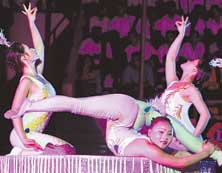| Plus |
|
|||
| Life
is a circus Their high energy dances and acrobatics, enhanced with dramatic lighting and spectacular costumes pay rich tribute to the historical elements of the Chinese people and culture. In keeping with this, haunting Chinese melodies are played and beautiful traditional handicrafts such as porcelain, dragons and lions are used as stage props. Of the feats themselves, there are those that exhibit the ability of retaining balance in motion; juggling objects with dexterity and manipulating a variety of objects ranging from ladders, poles and plates – all of which need unusual physical strength and perfect synchrony. Then in come the clowns from time to time, involving the audience much to their delight, in simple acrobatics. So
who are these artistes and what is their life in the circus like?
“It takes around six years for a student to be ready to perform,” explains Tinghe, Assistant Manager cum translator of the team. Since its inception in 1980, the school has trained more than 300 artistes and has more than four troupes travelling around the world. The arrangement and choreography change each time, depending on the demands of their hosts. So far the troupes have travelled to more than 40 countries in Europe, Australia and Asia. They have a manager, a cook, a trainer, a sound technician, an electrician and a translator who travel with them. Their costumes and equipment are made by their in-house designers. He Hai Yan (18) who does the balancing acts and several other astonishing feats takes pleasure in performing with the troupe. “I have always wanted to be an acrobat,” smiles this oriental beauty. Looking doll-like in her costume, she says the acts that she performs are simply part of her normal routine and she has been performing them since an early age. Not sure about what she wants to do in the future, she is concentrating on enjoying the present where she gets to visit new places and be exposed to new cultures. An only child, she visits her parents once a year. Jumping through hoops and doing the Lion dance is the most exciting part of his job, says the agile Dong Xen (20). He has trained at the school since he was six and seems completely at home with the company. “I just get very hungry after performances and I eat more,” he laughs when asked how he feels after a show. “I do worry about getting hurt,” he admits. He has enjoyed visiting Pinnawela and Kandy during their stay here. Artistes retire at 45 and receive a pension from the government which is equal to the pay they receive when in service. At that point, while some opt to stay home others seek different jobs or stay with the school to help with teaching or training. Laws that govern their country with regard to marriage apply to them too – the minimum age for women being 20 and men 22. “However most of them marry around 28 as they do in other parts of China,” he explains. Chinese
acrobatics involve long-stressed training of the waist and legs,
attaching great importance to the skill of standing on the head
and hands. Is
it risky? The performers are covered by life and medical insurance
and in the event of an accident, the school pays their wages for
the rest of their lives, Tinghe explains. But precautions are taken
as seen at the circus – those working at heights or at risky
positions have cables extended from the roof attached to them. Technicians
check their equipment every week. Proceeds of the shows in Colombo will go to the Lions Home for Street Children, a vision of Lion International District 306B2, said Coordinator of the project, Norbert Fernando. The circus will be in town until February 25.
Having relatively little to do over the long winters, Chinese farmers and craftsmen spent much of their time improving their talents. They practised with just about everything they could find around the house and farm – cups, saucers, tables, chairs, plates, etc., and even their own bodies with which they formed human walls and pyramids. While celebrating their bountiful harvest, a sort of Chinese Thanksgiving, the common people would show off their skills by performing exciting feats of daring and strength using common household items. Currently there are more than 30 Chinese acrobatic troupes that regularly perform at various destinations. Building on traditional performances, today’s artistes have added new techniques and spectacular stunts that they now present the world over. |
||||
Copyright © 2001 Wijeya Newspapers
Ltd. All rights reserved. |
 The
Sugathadasa Stadium has been bursting at the seams these past few
weeks. Thrilling audiences from around the country, adults and children
alike, with their feats of strength and daring, performed cleverly
and precisely is the Chinese Acrobatic Circus.
The
Sugathadasa Stadium has been bursting at the seams these past few
weeks. Thrilling audiences from around the country, adults and children
alike, with their feats of strength and daring, performed cleverly
and precisely is the Chinese Acrobatic Circus.